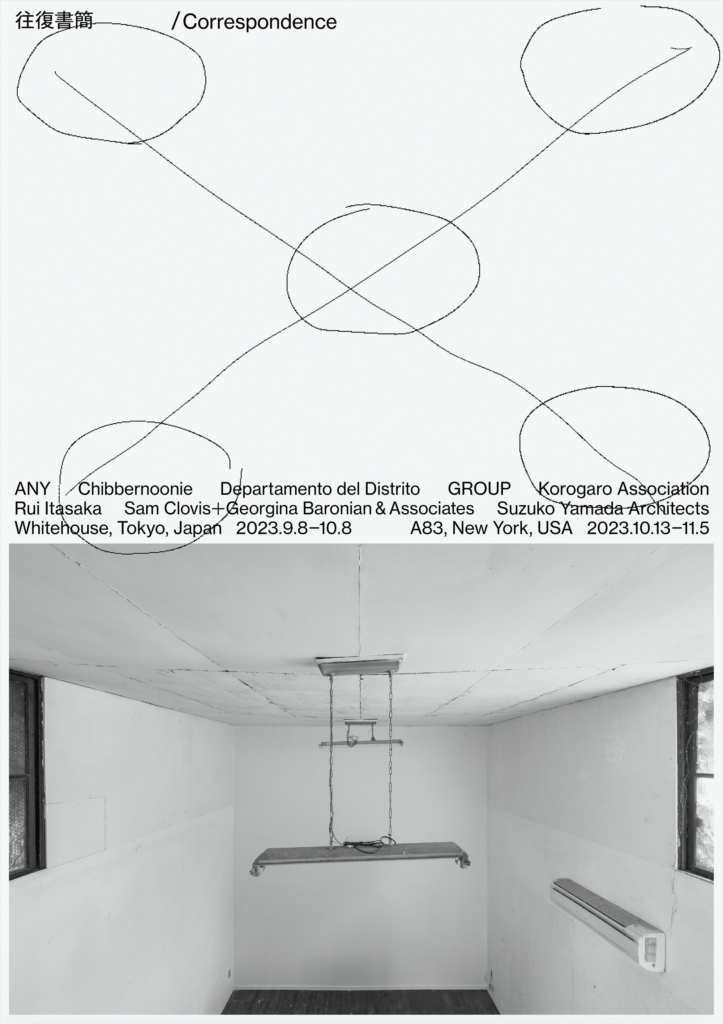新宿と大久保の喧騒からさほど距離のない、細い路地の行き止まりに、蔦に覆われた古い2階建ての建物がある。中に入ると、白い壁で囲まれた一辺5.4mの立方体、吹き抜けが広がる。《新宿ホワイトハウス》だ。

WH-026
往復書簡/Correspondence
TOKYO
#会期/Date:
2023/9/8~10/8
#会場/Venue
東京都新宿区百人町1-1-8 WHITEHOUSE
#開場時間/Opening hours
水木金14:00~19:00, 土日祝13:00~19:00
#出展者/artists and architects
ANY
Chibbernoonie
Departamento del Distrito
GROUP
Korogaro Association
Rui Itasaka
sam clovis + georgina baronian & associates
suzuko yamada architects
#会場構成/Exhibition design: w/
—–
New York
#会期/Date
2023/10/13~11/5
#会場/Venue
83 Grand St, New York, NY 10013 USA
#出展者/artists and architects
ANY
Chibbernoonie
Departamento del Distrito
GROUP
Korogaro Association
Rui Itasaka
sam clovis + georgina baronian & associates
suzuko yamada architects
青柳菜摘
河野未彩
布施琳太郎
三野新
村田啓
ARCHI HACH
#会場構成/Exhibition design
sam clovis + georgina baronian & associates
#主催/Organized by
GROUP
sam clovis + georgina baronian & associates
#制作/Produced by
佐久間萌香
#協力/Supported by
公益財団法人東京都歴史文化財団 アーツカウンシル東京[東京芸術文化創造発信助成]
DISTANCE.media, lull, Inc.
#キュレーション・編集/Curated & Edited by
井上岳
寺田慎平
服部真吏
涌井智仁
渡邊育
sam clovis
georgina baronian
#NY exhibition organizer
吉田山
#グラフィック/Graphics
石塚俊
#写真/Photographs
村田啓
At the end of a narrow alley, not far from the bustle of the very Tokyo-like area between Shinjuku and Okubo, lies an old two-story house covered in ivy. Stepping inside, a double-height space surrounded by white walls unfolds. The 5.4 x 5.4 x 5.4 m space seems to be vast in scale relative to the street. This is Shinjuku White House.
ここは元々、磯崎新の同郷のアーティスト、吉村益信のアトリエとして1957年秋に竣工し、1961年の吉村の結婚までネオダダの溜まり場だった。食料不足の時代に、まだ無名の貧しい芸術家たちが日夜集まって盃や議論を交わし、活発に活動を展開した。その後、空白の時代を経て、2000年代に赤瀬川原平が磯崎新のデビュー作として再発見。磯崎が設計の関与を認める。ただ、磯崎がどこまでデザインしたのか、いまだに謎は残る。近年はアートコレクティヴのChim↑Pomのアトリエとして、2021年にはGROUPによる改修が行われ、現在はギャラリー「WHITEHOUSE」となり使われている。
Initially built in Fall of 1957 as the studio of Arata Isozaki’s hometown artist, Masunobu Yoshimura, it was a base of the Neo-Dada Organizers until Yoshimura’s marriage in 1961. In the time of the postwar food shortage, the still unknown and poor young artists gathered day and night, exchanging sake cups and ideas. Then, after a period of absence in art history, in the 2000s, Genpei Akasegawa rediscovered it as Arata Isozaki’s debut work, which Isozaki had never previously acknowledged. Although the extent to how much of the building was designed by Isozaki remains a mystery, the building has recently been used as the atelier of the artist collective Chim↑Pom. In 2021 the architect collective GROUP renovated the space, which now operates as a gallery, WHITEHOUSE.
この《新宿ホワイトハウス》で、東京を拠点とするGROUPとカリフォルニアとテキサスを拠点とするclovisbaronianは、建築に関する国を超えたコミュニケーションを巡る展覧会を考えた。言うまでもなく、ホワイトハウスという名前はアメリカの大統領官邸のことで、戦後日本のアメリカに対する憧れを示唆している。それから半世紀以上を経て、価値観や技術、生活は大きく変わったが、依然として日本とアメリカ(の建築)は物理的、文化的な距離を隔てている。今日、どのようなコミュニケーションが行えるのか。そしてコミュニケーションによって私たちの建築に対する理解は更新できるのか。
For Shinjuku White House, GROUP, based in Tokyo, and clovisbaronian, based in California and Texas, envisioned an exhibition seeking transnational communication about architecture. More than half a century since the construction of Shinjuku White House, values, technologies, and lifestyles have changed dramatically, but they are still separated by physical and cultural distances. How can architects communicate now? Does this communication change our understanding of architecture?
これまでも建築家によって、コミュニケーションやディスカッションを通して建築を変えようとする試みが主導されてきた。例えば、ル・コルビュジエやジークフリート・ギーディオンによって組織された近代建築国際会議「CIAM」(1928-1959)は、建築の近代化を牽引した。また、ピーター・アイゼンマンや磯崎新、シンシア・ディヴィッドソン、イグナシ・デ・ソラ=モラレス・ルビオーなどによって開催された「Any会議」(1991-2000)は、ポストモダニズムの霧散的状況を乗り越えようとした。いま、彼らのコミュニケーションの記録は、彼らが設計した建築とともに建築のあり方を示している。
Architects have long attempted to update the idea of architecture through communication and discussion. The CIAM (1928-1959), an international conference on modern architecture organized by Le Corbusier and Sigfried Giedion, led the modernization of architecture. The Any Conference (1991-2000), organized by Peter Eisenman, Arata Isozaki, Cynthia Davidson, and Ignasi de Solà-Morales Rubió, sought to overcome the foggy conditions of postmodernism. The documentation of their communication today shows their conception of architecture, which is as powerful as the architecture they built.
展覧会の記録方法を相談するなかで、編集者の服部真吏から展示に先行して建築家たちのコミュニケーションを「書簡」という形式で発表していくというアイディアを得た。オンラインの時代にあっても簡単に会うことができない相手と1:1のディープなやりとりを積み重ねていくとき、いまの時代らしい書簡のあり方を模索していくことはできないだろうか。また、磯崎の《新宿ホワイトハウス》を舞台にした展示で磯崎について語りあっているその状況をDISTANCE.mediaの「磯崎特集」に掲載していく流れはとても自然にも思えた。こうして、建築家が国を横断してペアを組み、ともに磯崎について学び、考え、時にオンライン上で場をともにしながら展示作品をつくっていく展覧会「往復書簡」が生まれた。
While conceiving the exhibition concept and documentation, the idea of presenting the architects’ communication in the form of “correspondences” before opening the exhibition came from the editor, Mari Hattori. Even in the Internet Age, correspondence might be the best way to accumulate in-depth 1:1 communication with someone at a great distance. It seemed natural to communicate about Isozaki through an exhibition within Isozaki’s Shinjuku White House, and then to publish it online in the special feature on Isozaki. Accordingly, the exhibition “Correspondence” came into being: architects from different geographic locations are paired up to learn more about Isozaki and create new works.
「往復書簡」はオンライン上の「DISTANCE.media」のほか、日本とアメリカで展示を行う。日本からは、山田紗子建築設計事務所 、一般社団法人コロガロウ/佐藤研吾建築設計事務所 、板坂留五 、GROUPが、アメリカからは、ANY、Chibbernoonie、Departamento del Distrito、clovisbaronian が参加する。GROUPが日本の建築家を、clovisbaronianが北米の建築家を、それぞれが共感する活動を展開している建築家を熟考し選び出した。
“Correspondence” is exhibited online at “DISTANCE.media” as well as in Tokyo and New York. The participants are from Japan (Suzuko Yamada Architects, Korogaro Corporation / Kengo Sato Architects, Rui Itasaka, GROUP) and from North America (ANY, Chibbernoonie, Departamento del Distrito, clovisbaronian). GROUP and clovisbaronian collaborated to select participants of their generation whose work reflects a turn towards a playful pragmatism in architecture.
国を横断した4組のペアは、ドキュメント共有ファイルを用いて、英語で交互にテキストとイメージのやりとりを行う。ここでは4組が、磯崎新の言説や《新宿ホワイトハウス》以外の作品について言及しながら、展覧会場で磯崎新の設計の痕跡を追い、今年9月に展示される作品の設計を協働で進めていく。磯崎新に関しての対話とともに建築を取り巻く社会、経済、環境、そして文化に関する対話を重ねながら、展覧会場から空間をともに選び出し、そこに介入する設計を協働し展示することになる。
The four pairs exchanged images and texts in English using a document-sharing file online. Here, the pairs follow the traces of Arata Isozaki’s discourse and their design of the exhibition site. This conversation will result in a collaborative design work exhibited this September. Each dialogue about Arata Isozaki reflects on these architects’ views on our society, economy, environment, and culture surrounding architecture, leading to the selection of a space within the White House and the design of an intervention to be displayed there.
書簡を通して行われる私たちのコミュニケーションは、特定のアジェンダや野心を定義するのではなく、新しい仲間たちの間で密かに交わされた会話だ。ささやかな試みではあるが、過去の建築やコミュニケーションを前提に現代の出展作家達の対話から立ち現れつつある建築に期待してほしい。磯崎新は国を超えてどのように受容され、継承されているのだろうか。
We are seeking through our communication a somewhat humble outcome: not to define a singular agenda, but simply to have a quiet conversation amongst new colleagues. Please enjoy these conversations and look forward to new works inspired by reflections on his architecture. How is Arata Isozaki received by a younger generation of architects, both within and beyond the context of Japan?
井上岳/Gaku Inoue (Group)
サム・クローヴィス/Sam Clovis (clovisbaronian)
ジョジーナ・バロニアン/Georgina Baronian (clovisbaronian)
服部真吏/Mari Hattori
この度WHITEHOUSEでは、展覧会「往復書簡/Correspondence」を開催いたします。
本展覧会は、ANY、Chibbernoonie、Departamento del Distrito、GROUP、Korogaro Association、Rui Itasaka、sam clovis + georgina baronian & associates、suzuko yamada architectsの8組の建築家/スタジオによるオンライン上での往復書簡を下敷きに、展開されていきます。往復書簡はDISTANCE.media上で公開されていますので、是非ご覧ください。
8組の建築家/スタジオは主催であるGROUPとclovisbaronianによって4組ずつ選出され、それぞれが1組ずつ対応する形で4組のペアを作り、テキストやイメージを交換しながら、数ヶ月間の往復書簡を重ねました。磯崎新の気配を追いかけながら行われたそれぞれの手紙のやりとりは、WHITEHOUSEの余白に今あり得るべき設計の姿を繋ぎ止めていくように、厳かに作品へと結実されていきました。
新宿ホワイトハウス以外の様々な磯崎新の作品・プロジェクト、言説について話し合いを重ねながら、磯崎新を解釈し直していく作業は、GROUPが以前WHITEHOUSEで行ったプロジェクトとも共振しています。
2021年11月にGROUPは、WHITEHOUSEで展覧会「手入れ/Repair」を開催しました。その際に、彼らは「手入れ」という手法の持つ、特殊な時間性を表面化しようと試みました。「手入れ」とは、その対象に蓄積された時間を暴き、別の時間を新しく与えるための行為です。「手入れ」を通過した対象は、表面上は元の空間と連動しつつ、その内部で別の時空間を生きることになります。対象とその対象を抱え込む空間は、生と死を錯綜させながら生きることを宿命化させられ、それは時間を重ねるごとに、より複層化していきます。この「手入れ」という手法と、都市空間が持っている「手入れ」の代謝機能、そして約60年の時間の中で新宿で起きた具体的な出来事を重ね合わせながら、GROUPは演劇的な身振りでWHITEHOUSEの「手入れ」を行いました。
この「手入れ」の手法は、本展覧会「往復書簡/Correspondence」においては、磯崎新という建築家へと向けられています。
WHITEHOUSEに残された様々な痕跡に、「往復書簡」という形で「手入れ」を施していく。それは新宿ホワイトハウスからWHITEHOUSEまで積層されていった無数の時間たちを暴き出すことであり、そして、解釈をすることで新しい時間を先取りしていくような取り組みです。
複数の国とチームによって共同で行われているこの展覧会は、「往復書簡」「手入れ」という2つのフォームによって、空間に対する新しい介入方法を模索する場になるはずです。それは日常的なささやかな取り組みから空間を生き直すこと、また、生きることそのものを建築にすることにしていくような取り組みになっていくと思います。
この展覧会はWHITEHOUSEで展開された後、その成果をさらに別のアーティストたちの対話の中に開くことで、リブートされていきます。
会場はニューヨークのa83で行われ、建築や設計とはまた別のフォームによって、この「往復書簡」が続いていきます。
限りあるはずの手紙のやり取りを何度も読点で止めながら続けていく、彼らの「往復書簡」の空間を存分にご鑑賞いただけたらと思います。
涌井智仁